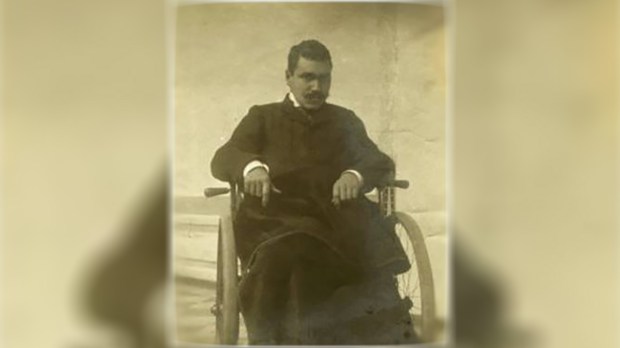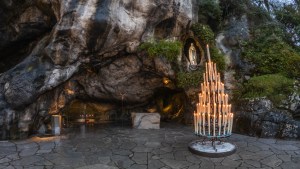It seems almost too dramatic, or cinematic, to be true: a young man in a wheelchair, born into a noble family but humiliated by sickness, approaches the grotto of Lourdes with a hidden gun and a plan to publicly take his life if he is not miraculously healed. Then, at the last minute, he receives the grace of spiritual healing and conversion.
This is the true story of Giovanni (“Gian”) Battista Tomassi, who went on to found a volunteer organization—present throughout all of Italy—which brings the sick on pilgrimages to Lourdes and other shrines. More than 100 years after its founding, the organization—UNITALSI, short in Italian for “National Italian Union for Transporting the Sick to Lourdes and International Shrines”—is going stronger than ever.
Tomassi was born in Rome on November 29, 1880, into a family of minor nobility; his father was the administrator of the Barberini family, which has given the world popes and princes. As recounted on the UNITALSI website, from an early age Tomassi suffered from a serious form of arthritis that caused irreversible physical deformations and forced him to remain in a wheelchair. Unable to accept his physical suffering, he rebelled against God and the Church.
In September 1903, at the age of 22, he asked to participate in a pilgrimage to the Marian shrine at Lourdes, at the foot of the Pyrenees. He did so with a specific intention, which was a challenge thrown at God, whom Tomassi considered was either responsible for his state or cruelly disinterested in it. He planned to arrive in front of the grotto of Massabielle and take his own life by shooting himself and shouting all his anger against the God, who had left him in such a state. He gave God only one option to stop him: to cure him of his illness.
“Our Lady won”
Arriving in front of the grotto where Mary revealed herself as the Immaculate Conception to little Bernadette, Gian Battista was struck by something he hadn’t accounted for in his desperate chess game with the Eternal Father: the volunteers who care for the sick and help them with great thoughtfulness and delicacy to enter the grotto.
He was overcome by what he experienced: it was such a consoling relief to see his suffering shared and borne by total strangers, whom he discovered to be brothers.
From a suicidal intent to a great project of charity
Although initially his intention was to take his own life, it became that of giving it to others. He got rid of the firearm because he now wanted to use his hands to carry out a new, very specific plan. The UNITALSI website described what happened:
(…) At the time of his return, he asked to speak with the spiritual director of the pilgrimage, Bishop Radini Tedeschi, to whom he said, handing over the gun:
“Our Lady won. Here, I don’t need it anymore! The Virgin has healed my spirit.”
And he added: “If Lourdes has done good to me, it will do good to many other sick people.”
An unexpected healing and gratitude: UNITALSI is born
Our Lady had won, it’s true: Tomassi had been cured in a way that he was not yet accustomed to considering, caught in the grip of the physical and existential pain that had so exasperated him. That young man found himself healed in his heart, and with newborn creativity that led him to decide to set up an organization to help others who were suffering too.
The presence of a future pope
Among those who witnessed his extraordinary change—the kind that only conversion can provoke—there was, in addition to the bishop, also a young priest from Bergamo, a certain Fr. Angelo Roncalli: the future Pope John XXIII. It was to them that Gian Battista firmly declared that he wanted to found an association dedicated to assisting sick pilgrims who go to Lourdes: UNITALSI, Unione Nazionale Italiana Trasporto Ammalati Lourdes Santuari Internazionali (National Italian Union for Transporting the Sick to Lourdes and International Shrines).
Looking at the history of this association that has grown immensely since then, we cannot but be astonished by the excellence of the service it offers and by its perfect fidelity to the aims that the founder had set himself just after having been touched by grace. The industrious work of the hundreds of volunteers, stretcher bearers, guides, and organizers who accompany those most in need, principally to Lourdes but also to other shrines, “certainly represents one of the best examples of charity in Italian Catholicism,” according to UCCR.
The charity of volunteers, an instrument for the healing of hearts
The volunteers, with their attentive care and such charitable service, were already at the service of Our Lady, her privileged instrument for a great number of miracles, many of which are counted at Lourdes as spiritual healings. It’s precisely in virtue of this kind of grace that Tomassi himself radically changed his existential viewpoint, and went from being a desperate man defying God to a witness of joy and hope.
Miracles aren’t arguments, but existential events
What changed Tomassi wasn’t an argument that the sick young nobleman came up with on his own in front of the grotto; it was an event, like every miracle—an encounter with the divine. In fact, he recounted that he had distinctly and suddenly felt a deep sense of relief that he had never felt before.
The UCCR website describes this transformation thus: “Having left as an atheist with the intention of committing suicide, he returned from Lourdes converted and at peace with himself, with God and with his illness.”
Grace and human intelligence
Tomassi didn’t limit himself to giving voice to the enthusiasm that had filled him at the moment of his conversion; he obeyed divine inspiration in the most intelligent way, putting himself to work and making full use of his capacities. Of the many works of charity that can arise from beneficent interior impulses, the first and most important is to make them actually work, to make them stand on their own, to be efficient, well thought out and well executed.
This is how Tomassi acted, structuring in a functional and organized manner the association which has more than 70,000 members today, and which for more than a century has served millions of pilgrims, putting those who suffer the most at the center.
Freedom of the Spirit, in fact, does not translate into improvisation and approximation; quite the contrary.
Gian Battista Tomassi died on April 25, 1920, in peace, after having seen for 17 years the miracle of the numerous volunteers on the now-famous white trains, bringing countless people to an encounter with God and with Mary, often leading to spiritual and, sometimes, physical healing.



